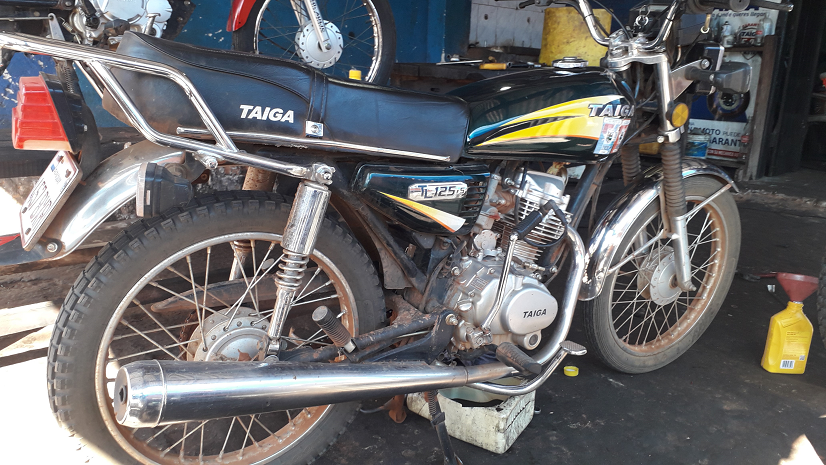For getting around in the Paraguayan countryside with all its rough dirt roads two types of vehicles are ideal.
One is a good quality 4×4. Solidly built and with good ground clearance. The other is a cheap motorbike.
I myself opt for a cheap motorbike as my transport solution.
There are several brands available in Paraguay. However despite the differences in name they are all basically the same. Each brand has a few individual touches but beyond that they are identical.
The result of that is that on the whole they all use the same spare parts. This makes life much simpler for any little motorbike repair shop in keeping down the number of spares they need keep. It also means that they know that every bike is bolted together in pretty much the same way.
It is not that surprising that the bikes are all much the same. They are all however they may be branded generic Chinese bikes. The same as are exported all around the world.
The majority arrive in Paraguay complete although some are assembled from parts in the country. Bringing some jobs to the country.
These bikes are simple and sturdy. Can take a lot of punishment and have very few extra or unnecessary bits of body work.
Designed for a warm climate the engines are exposed and air cooled. So no need for any coolant or cooling system. Also most of the components are exposed and easily accessible to a mechanic with the most basic of tools.
As would be expect from anything so inexpensive, the most basic cost less than £400 new, and obviously basic the individual parts are not of the highest quality.
And so although the bikes can take a huge amount of misuse before failing completely regular maintenance is required to keep them running well.
A well maintained bike will run for years and years whereas one that isn’t may be little more than scrap after a couple.
To ensure that mine is one of those that keeps on running, with everything working, it gets regular trips to a garage.
To be kept in the best of conditions a full service is needed about every 1500 km. That is not a huge distance, but just pottering around country roads places visits to the garage several months apart.
Also I have found over the years that here in Paraguay in pays to build a good relationship with a particular mechanic and always to return to his garage.
When I take my bike in to be serviced it is always done while I sit and wait. Sometimes I may have to wait an hour or so to get seen two if their are others there first. Never though is there any need to book a service. I’m sure it would throw people into confusion if I suggested doing such a thing.
When the bike is serviced everything mechanical is looked at and adjusted. With anything that may have been worn out being replaced.
First though the old dirty engine oil is drained out. The last few drops will drain out whilst the mechanical parts are dealt with.
The brakes front and rear are tested and adjusted. These always work loose with use. By the time of a service it is normal for one or the other to be barely working. After being adjusted the brakes will then be sharp for a couple of days until they loosen off a little.
Next the sponge that is the air filter is removed and cleaned. Driving around mostly on dirt roads this soon become choked with sand. A few drops of petrol from the fuel tank are enough to lift the sand from the sponge.
After that the chain will need to be tightened. Chains always work themselves loose. Often the chain will need tightening long before a service is due and then again when the rest of the bike is seen to.
Once all exposed features have been seen to it is the turn of the engine itself. Top of the engine block comes off and the pistons and cylinders adjusted to be firing just right.
It may seem strange that this needs doing so often, but it is a reflection of the quality of the materials from which the the vehicles are made.
Then the stopper is put back in the engine and fresh oil added.
A quick test of the engine will tell if anything further needs working on.
From time to time the carburetor will need to be removed and cleaned out. The petrol can be quite dirty and that eventually blocks carburetors up.
Then once satisfied that all is looking and sounding correct the mechanic may go for a quick trip round the block to make sure nothing else needs attention.
Assuming it does not I will be on my way confident that the bike will run problem free for the next few months.
And how much does this all cost?
For this full service checking all that could be checked mechanically, just a couple of pounds. And for a fresh bottle of engine oil, another couple of pounds.
For this negligible sum a bike can be kept running almost like new for many years.
And bouncing down a dirt track on a little motorbike is just so much more fun than being high up in the air in a big comfortable car.


Recent Comments